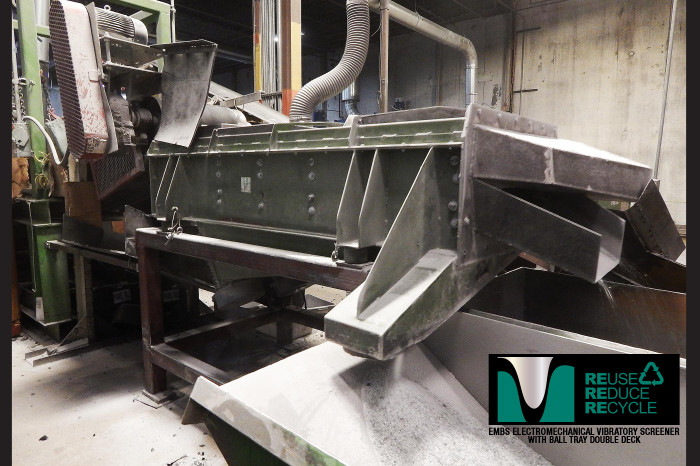Remember the days of “Tube TVs” and “Low Radiation” computer screens?
I remember walking into Cleveland Vibrator and seeing, what I would describe as, the land of misfit computer screens that had been stored away through the many years that Cleveland Vibrator has been in business. One day they disappeared and the land of misfits was replaced by trade show accessories. Working here has opened my eyes to the many industries that don’t get the attention they well deserve, especially recycling. Recently, I was invited to visit a customer whose specialty was Glass Recycling of old TV screens and computer monitors. Ding, ding, ding, the lightbulb went off… this is where those “misfits” disappeared to. This got me thinking, what exactly can recycled glass be used for?
The glass used for these old monitors and displays is referred to as CRT, Cathode Ray Tube Glass, and it is estimated that the typical CRT device is made up of between 15 to 90 pounds of glass (depending on device) that protects the users from the radiation produced by the electron gun and beam gun inside that device. Since the emerging high demand of LCD, LED and Plasma Screens of the 2000s, it is an estimated 57 million computers and televisions are sold annually in the U.S. according to U.S. Environmental Protection Agency. Households are now discarding old models of outdated technology at a much higher rate than we have ever seen before.
The E-waste Recycling Industry is on the up-and-coming, with a reported 7.2 million tons of CRT devices remaining to be recovered from homes and business throughout the United States. Which will result in the projected processing of 206,000 to 392,000 tons of CRT glass in the next 10 years. This is where our customer I visited comes into play.
I was able to witness their process of recycling such glass. The customer’s operations run 24 hours a day, 7 days a week, and in three shifts allowing them to keep up with the capacity of CRT products that are currently shipped daily to their warehouse. The computers and TVs are disassembled and categorized into device parts. From there, the glass is sent into a pulverizer then it must be sorted according to its size – which is where Cleveland Vibrator comes in. We went to check out our EMBS Electromechanical Double Deck Screener fit with a custom Ball Tray Deck to relieve the screen of plugging and blinding, that is currently being used in their facility. They are looking for a sister piece of equipment which would allow for some downtime per equipment piece in their 24 hour operations. The Vibratory Screener separated the fines and dust from the usable recycled glass while also removing over-sized pieces to be re-pulverized to the correct size. You can see this Screener in action at this facility on our YouTube Channel.
So who needs recycled CRT Glass anyways?
CRT Glass can be successfully incorporated as fine aggregate in a concrete mix, providing strength and workability characteristics equivalent to a control mix using traditional aggregate materials. Typically, it replaces sand in concrete mixes which then earns it the name GFRC, glass-fiber reinforced concrete. This was the particular use our customer was catering to as an end user for their glass recycling process.
Upon researching it further, CRT Glass has also been used as a substitute for raw materials in the processing of Ceramic products. The idea of combining CRT Glass with cement tile and bricks to be tested, labeled and sold specifically for applications where lead shielding is required, such as X-Ray rooms, has been entertained as well.
A company called NuLife Glass has also found a way to successfully melt down CRT Glass, remove the lead from the glass mixture and repurpose it for road surfacing, grit blasting, floor screeds and higher value decorative glass products. You can check out their site here.
It takes 1 million years for a single glass bottle to decompose in a landfill. Think how long it would take for a computer monitor or 48″ Tube tv screen to break down. Today, Americans discard more than 2 million tons of obsolete electronic products annually. The EPA is now sponsoring the Sustainable Materials Management Electronics Campaign. OEMs (original equipment manufacturers) and retailers such as Best Buy, Samsung, LG and Sprint collect your unwanted electronics and send them to a third-party certified recycler. Other major corporations will be taking part soon so stay tuned.
I hope that this edition of Solutions In Motion was somewhat eye-opening and entertaining. Remember: Reduce, Reuse, Recycle. There are many companies out there that are working to keep our world healthy for generations to come and we are proud to contribute. Until next time, Movers & Shakers! #ShakeOn!
Does your company need help sizing and separating your materials? We can help. Contact us today for additional information about our custom Fabricated Vibratory Equipment.

Katy Sabo has been the Industrial Vibrator Duchess of The Cleveland Vibrator Company since 2014. The originator of #VibrationEducation, Katy has helped create CVC brand awareness across the globe and has made it her personal priority to share the importance of Industrial Vibration with anyone willing to listen! When she isn’t shaking things up in the Marketing Department, you can usually find her shopping with her favorite sidekicks (she’s the proud mom of two little ladies), going on long walks/runs with her favorite furry family members, or rooting on any Cleveland team with her diehard fan of a husband.
Share this blog post:
Follow us:


